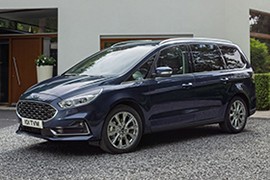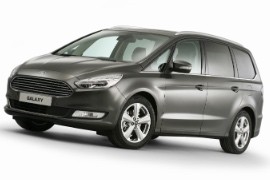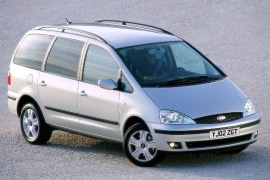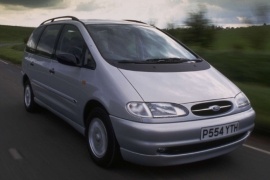FORD Galaxy Models/Series Timeline, Specifications & Photos
First production year: 1995
Engines: Gasoline, Diesel
Body style: Van
Ford introduced the third generation of the Galaxy MPV in Europe in 2015, and after four years, it refreshed it, trying to keep up with the market changes in terms of styling, emission levels, and technology.
The European minivan segment was highly contested by several brands, and Ford tried to impose the Galaxy as a stylish, family-friendly vehicle but with several sports-inspired details. Starting with the 2019 model year, the blue-oval brand aligned the styling with the Mondeo, with which it shared its platform. Unlike the market-segment leader, the Renault Espace, the Galaxy was available with potent engines and all-wheel-drive versions. Moreover, it provided options fit for luxurious vehicles, but unlike the Sharan from Volkswagen, it lacked sliding rear doors that were easier to use in tight parking spots. As a result, the sales were not impressive, and in 2022, Ford decided to pull the plug on its largest European minivan.
At first sight, it was not significantly changed compared to its predecessor, but still, a keen eye for detail could notice the clear-lenses fog lights and the enhanced headlights. In addition, the top-spec version sported a nice hexagonal grille fitted with a 3D-mesh styling and surrounded by a chromed rim. Furthermore, the lower bumper had a lower lip and side scoops adorned with shiny silver trims. From its profile, there were no significant changes. The main advantage of the Galaxy over its competitors was its wide rear doors, which eased ingress and egress to the vehicle. Finally, at the back, Ford offered a hands-free opening tailgate. The taillights were also restyled.
Inside, the Galaxy was a true family and friends hauler. There were three rows of seats where up to eight adults could sit in a 2-3-2 layout. At the front, the high-mounted seats featured individual armrests and were separated by a tall center console that housed the gear stick, a pair of cup holders, and an armrest with a storage area underneath it. One of the most important upgrades of the 2019 Galaxy was noticed on the center stack. There, Ford installed a brand-new infotainment system fitted with an eight-inch touchscreen. Furthermore, the driver could use voice commands and the buttons on the steering wheel. The second row of seats could slide and tilt forward to ease access to the rearmost seating position. There were loads of headroom for everyone and enough legroom for six-feet passengers.
Under the hood, the improved gasoline engine lineup consisted of two turbocharged units, while the turbodiesel range was covered by a choice of four two-liter powerplants ranging between 120 PS (118 hp) and 210 PS (207 hp). Power went to the front or all four wheels via either a six-speed manual or a six-speed automatic, depending on the engine version and options.
The Galaxy was the answer given by Ford to Europe in the matter of 7-seater vehicles. It was the car designed for people who needed more room or, why not, more seats. Even if the MPV market in Europe dropped in favor of the SUV, this kind of people-carriers was still appreciated in 2015, when the fourth generation of Galaxy was launched.
The 2016 Ford Galaxy kept the dimensions from the previous generation but added more style. It follows the Kinetic Design language that could be seen on other Ford models. It added thinner headlamps, new LED taillights for a stylish look. Ford claims that since the vehicle is built on a car platform, it has a better feeling for the passengers compared to that from a utility vehicle transformed into a people-carrier.
The big, 4848 mm (15.9 ft) long vehicle could accommodate seven adult passengers. It offered enough room even for the last row. The middle row could tilt and slide forward for ease of access. The features offered in the Galaxy are good. The traditional instrument cluster could have been replaced with an optional 10” digital screen.
The engine range is big and filled all the needs for the users. For the diesel version, there was a range from 110 hp up to a 210 hp engine, as for the gasoline versions, that offered between 160 and 240 hp. For some versions, the Galaxy could have been fitted with all-wheel-drive, all-wheel-steering and 8-speed automatic transmission.
The first Galaxy developed without further intervention from Volkswagen was the third generation released in 2006.
One of the strongest rivals on the market was from its own stable, the Ford S-Max, with which the Galaxy shared many of its underpinnings.
In simple words, the Galaxy was more practical, while the S-MAX was more fun to drive and had sharper visuals.
Longer than an S-Max by 52mm and wider by 65mm, the Ford Galaxy was a people carrier offering seating for 7. Its suspension was tuned for comfort, the tall roof ensured great headroom and the big trunk offered 435 liters of cargo.
Unusual for a bulky MPV, the Galaxy was still fun to drive while equipped with the punchy 2.0-liter TDCi Diesel engine that developed 142 hp. Other engine choices were available.
Accessing the 3rd row of seats was a little difficult to access, but once inside, occupants had great room. The second row of seats was mounted on rails, thus expanding the room in the 3rd row was possible.
Inside, the Galaxy was fitted with a new instrument easy-to-read instrument cluster and a leather-wrapped steering wheel with mounted toggle controls for the Ford’s Human Machine Interface.
No compromise was made when it came to safety and the Galaxy was equipped with lots of active and passive safety systems.
FORD Galaxy 1.8L TDCi 5MT FWD (101 HP)
FORD Galaxy 1.8L TDCi 5MT FWD (126 HP)
FORD Galaxy 2.0L TDCi 6AT FWD (140 HP)
FORD Galaxy 2.0L TDCi 6AT FWD (163 HP)
FORD Galaxy 2.0L TDCi 6MT FWD (131 HP)
FORD Galaxy 2.0L TDCi 6MT FWD (140 HP)
FORD Galaxy 2.0L TDCi 6MT FWD (163 HP)
After five years on the market, Ford refreshed the Galaxy lineup and gave it a new design language that the automaker named “New Edge,” trying to attract younger customers.
The European minivan market was not very large in the mid-90s, and that segment was already highly contested by the Renault Espace, which had been on the market since the early ‘80s. So, the only thing Ford and Volkswagen could do was to provide a better vehicle with a lower production cost. For that, the automakers shared an assembly line in Portugal where the Ford Galaxy, Volkswagen Sharan, and Seat Alhambra were made. The recipe worked, so after five years, the three vehicles got facelifted.
Ford followed the design language introduced by the Focus’ first generation, installing triangular, swept-back headlights on the refreshed Galaxy MPV. Between them, the automaker added a slightly curved and narrow grille that sported the blue-oval badge. Lower, on the bumper, the automaker placed a secondary air intake needed to cool the engine. As an option, customers could have the car with fog lamps mounted on the outer sides of the apron. The design changes were so massive that the vehicle looked like a completely new generation.
From its profile, the panoramic windshield followed the same line as the short hood. The body-colored door mirrors and door handles replaced the older black ones. Still, the rubber stripes that protected the bodywork were black or painted, depending on the trim level. Ford offered the car with standard steel wheels, but alloy ones were also available. The Galaxy featured four regular doors, ditching the idea of installing sliding ones, which were more expensive. Finally, at the back, the new corner-mounted taillights were larger and extended from the quarter panels to the redesigned tailgate.
Inside, Ford placed a flat and low dashboard fitted with several storage compartments both on top and underneath it. In front of the driver, the automaker placed the instrument cluster with a rounded upper visor that resembled the one from a Volkswagen Passat. Inside it, the panels sported large dials for the speedometer and tachometer and two additional gauges on its upper side. An LCD took center stage for additional information from the car’s onboard computer. With seating for up to seven passengers on three rows, the Galaxy was an adequate vehicle for large families or a family with many friends. Besides the front row, all the other seats could be removed to create a vast loading area.
Under the hood, Ford installed a choice of diesel and gasoline engines carried over from Volkswagen. The most powerful version was a 2.8-liter V6 paired with a six-speed manual. A smaller, 2.3-liter gasoline engine supplied by Ford was also available.
Developed as a joint project with Volkswagen, the Galaxy's first generation came on a market dominated by the French MPVs from Renault and PSA.
Ford had the MPV experience and used it when it allied with Volkswagen in the AutoEuropa project. The two big carmakers agreed to build the vehicles in Spain and offered them under different badges as SEAT Alhambra, Volkswagen Sharan, and Ford Galaxy.
The aerodynamically shaped MPV started with a sloped front end, with the raked windshield followed the same line as the hood. Ford used similar-shaped headlights as those installed on the Mondeo and an oval grille with its blue badge. The customers did not very like its thick A-pillars, but they were there for better protection. A small, triangular window was mounted between the A-pillar and the door opening. A red strip with lights was extended between the rear quarter panels over the tailgate in the rear.
Inside, the Galaxy was fitted as standard with five seats on the base trim level but was available with seating for up to seven in a 2-3-2 configuration. Despite being slightly longer than a regular compact-segment station-wagon, it offered plenty of room for them, but the trunk was not that big with all the seats up. With them removed, it could relocate a teenager from home to college in one trip.
Under the hood, Ford carried over most of Volkswagen engines but came with two of its own, the 2.0-liter and the 2.3-liter, both with gasoline.




